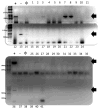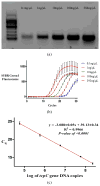Direct Detection and Quantification of Bacterial Genes Associated with Inflammation in DNA Isolated from Stool
- PMID: 25635239
- PMCID: PMC4307837
- DOI: 10.4236/aim.2014.415117
Direct Detection and Quantification of Bacterial Genes Associated with Inflammation in DNA Isolated from Stool
Abstract
Although predominantly associated with health benefits, the gut microbiota has also been shown to harbor genes that promote inflammation. In this work, we report a method for the direct detection and quantification of these pro-inflammatory bacterial genes by PCR and qPCR in DNA extracted from human stool samples. PCR reactions were performed to detect (i) the pks island genes, (ii) tcpC, which is present in some strains of Escherichia coli and (iii) gelE presented in some strains of Enterococcus faecalis. Additionally, we screened for the presence of the following genes encoding cyclomodulins that disrupted mammalian cell division: (iv) cdt (which encodes the cytolethal distending toxin) and (v) cnf-1 (which encodes the cytotoxic necrotizing factor-1). Our results show that 20% of the samples (N = 41) tested positive for detectable amounts of pks island genes, whereas 10% of individuals were positive for tcpC or gelE and only one individual was found to harbor the cnf-1 gene. Of the 13 individuals that were positive for at least one of the pro-inflammatory genes, 5 were found to harbor more than one. A quantitative version of the assay, which used real-time PCR, revealed the pro-inflammatory genes to be in high copy numbers: up to 1.3 million copies per mg of feces for the pks island genes. Direct detection of specific genes in stool could prove useful toward screening for the presence of pro-inflammatory bacterial genes in individuals with inflammatory bowel diseases or colorectal cancer.
Keywords: Gut Inflammation; Microbial Biomarkers; Microbiota; PCR; Stool Samples.
Figures



Similar articles
-
The Presence of Genotoxic and/or Pro-inflammatory Bacterial Genes in Gut Metagenomic Databases and Their Possible Link With Inflammatory Bowel Diseases.Front Genet. 2018 Apr 10;9:116. doi: 10.3389/fgene.2018.00116. eCollection 2018. Front Genet. 2018. PMID: 29692798 Free PMC article.
-
The Presence of Gut Microbial Genes Encoding Bacterial Genotoxins or Pro-Inflammatory Factors in Stool Samples from Individuals with Colorectal Neoplasia.Diseases. 2019 Feb 1;7(1):16. doi: 10.3390/diseases7010016. Diseases. 2019. PMID: 30717148 Free PMC article.
-
Cytotoxic Escherichia coli strains encoding colibactin, cytotoxic necrotizing factor, and cytolethal distending toxin colonize laboratory common marmosets (Callithrix jacchus).Sci Rep. 2021 Jan 27;11(1):2309. doi: 10.1038/s41598-020-80000-1. Sci Rep. 2021. PMID: 33504843 Free PMC article.
-
Hotspots of Sequence Variability in Gut Microbial Genes Encoding Pro-Inflammatory Factors Revealed by Oligotyping.Front Genet. 2019 Jul 9;10:631. doi: 10.3389/fgene.2019.00631. eCollection 2019. Front Genet. 2019. PMID: 31354787 Free PMC article.
-
Necrotoxic Escherichia coli (NTEC): two emerging categories of human and animal pathogens.Vet Res. 1999 Mar-Jun;30(2-3):221-33. Vet Res. 1999. PMID: 10367356 Review.
Cited by
-
The Presence of Genotoxic and/or Pro-inflammatory Bacterial Genes in Gut Metagenomic Databases and Their Possible Link With Inflammatory Bowel Diseases.Front Genet. 2018 Apr 10;9:116. doi: 10.3389/fgene.2018.00116. eCollection 2018. Front Genet. 2018. PMID: 29692798 Free PMC article.
-
A One Health Perspective for Defining and Deciphering Escherichia coli Pathogenic Potential in Multiple Hosts.Comp Med. 2021 Feb 1;71(1):3-45. doi: 10.30802/AALAS-CM-20-000054. Epub 2021 Jan 8. Comp Med. 2021. PMID: 33419487 Free PMC article. Review.
-
Identification of Cartilage Microbial DNA Signatures and Associations With Knee and Hip Osteoarthritis.Arthritis Rheumatol. 2020 Jul;72(7):1111-1122. doi: 10.1002/art.41210. Epub 2020 May 12. Arthritis Rheumatol. 2020. PMID: 31961065 Free PMC article.
-
Colicin Z, a structurally and functionally novel colicin type that selectively kills enteroinvasive Escherichia coli and Shigella strains.Sci Rep. 2019 Jul 31;9(1):11127. doi: 10.1038/s41598-019-47488-8. Sci Rep. 2019. PMID: 31366939 Free PMC article.
-
Evaluation of cinnamon extract effects on clbB gene expression and biofilm formation in Escherichia coli strains isolated from colon cancer patients.BMC Cancer. 2020 Mar 30;20(1):267. doi: 10.1186/s12885-020-06736-1. BMC Cancer. 2020. PMID: 32228495 Free PMC article.
References
-
- Balter M. Taking Stock of the Human Microbiome and Disease. Science. 2012;336:1246–1247. http://dx.doi.org/10.1126/science.336.6086.1246. - DOI - PubMed
-
- Eckburg PB, Bik EM, Bernstein CN, Purdom E, Dethlefsen L, Sargent M, Gill SR, Nelson KE, Relman DA. Diversity of the Human Intestinal Microbial Flora. Science. 2005;308:1635–1638. http://dx.doi.org/10.1126/science.1110591. - DOI - PMC - PubMed
-
- Blaser M, Bork P, Fraser C, Knight R, Wang J. The Microbiome Explored: Recent Insights and Future Challenges. Nature Reviews Microbiology. 2013;11:213–217. http://dx.doi.org/10.1038/nrmicro2973. - DOI - PubMed
-
- Qin J, Li R, Raes J, Arumugam M, Burgdorf KS, Manichanh C, Nielsen T, Pons N, Levenez F, Yamada T, Mende DR, Li J, Xu J, Li S, Li D, Cao J, Wang B, Liang H, Zheng H, Xie Y, Tap J, Lepage P, Bertalan M, Batto J, Hansen T, Le Paslier D, Linneberg A, Nielsen H, Bjorn, Pelletier E, Renault P, Sicheritz-Ponten T, Turner K, Zhu H, Yu C, Li S, Jian M, Zhou Y, Li Y, Zhang X, Li S, Qin N, Yang H, Wang J, Brunak S, Dore J, Guarner F, Kristiansen K, Pedersen O, Parkhill J, Weissenbach J, Bork P, Dusko Ehrlich S, Wang J. A Human Gut Microbial Gene Catalogue Established by Metagenomic Sequencing. Nature. 2010;464:59–65. http://dx.doi.org/10.1038/nature08821. - DOI - PMC - PubMed
-
- Wikoff WR, Anfora AT, Liu J, Schultz PG, Lesley SA, Peters EC, Siuzdak G. Metabolomics Analysis Reveals Large Effects of Gut Microflora on Mammalian Blood Metabolites. Proceedings of the National Academy of Sciences of the United States of America. 2009;106:3698–3703. http://dx.doi.org/10.1073/pnas.0812874106. - DOI - PMC - PubMed
Grants and funding
LinkOut - more resources
Full Text Sources
Other Literature Sources
Miscellaneous
